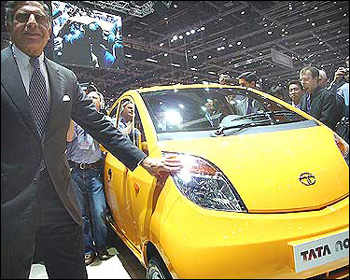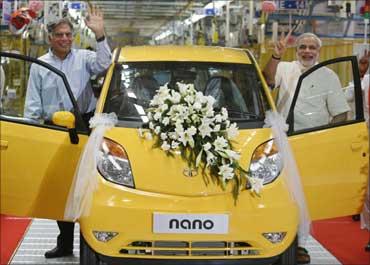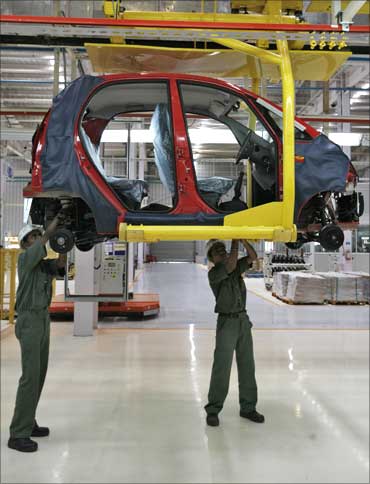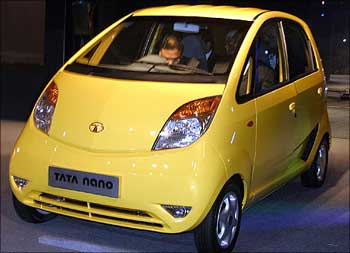Photographs: Reuters Sohini Das in Ahmedabad
Sanand, which shot to fame overnight as the home to the world's cheapest car -- Nano, has another reason to cheer.
Rising land deals, thanks to Tatas' decision to shift the ultra-low-cost car project here from Singur in West Bengal, have created villages full of crorepati farmers in Sanand.
At the rate of around Rs 40 lakh (Rs 4 million) for a bigha (0.62 acre), selling a couple of bighas can fetch one Rs 1 crore (Rs 10 million).
Consider this: Nazir Khan of Chharodi village sold around four bighas for the approach road to the Nano plant from the highway.
In 2009, the deal got him around Rs 1 crore, at the rate of Rs 25 lakh (Rs 2.5 million) per bigha.
. . .
Sanand now a home to crorepati farmers
Photographs: Reuters
"I bought two cars and now, rent them at the plant's car pool," he said. Khan has some more farmland left to sustain his living.
His cousin, Shamshir Khan, sold around eight bighas and is richer by six tractors and two cars.
Land prices, however, have shot through the roof in the last seven-eight months, after the Gujarat Industrial Development Corporation announced its plans to come up with an engineering estate near the Nano plant.
According to Khan, a bigha now costs around Rs 30-40 lakh (Rs 3-4 million) in some areas that are close to the highway.
. . .
Sanand now a home to crorepati farmers
Image: Ratan Tata (L), chairman of the Tata Group, and Gujarat's chief minister Narendra Modi.Photographs: Amit Dave/Reuters
It was hardly Rs 500,000-600,000 a bigha three years ago.
GIDC is shelling out Rs 1,200 per square meter to acquire land for its project that is coming up over 700-odd acres.
Sources in the state revenue department indicated that in the last two-three months, around 1,000 land deals per month had been struck in the area.
While exact figures are difficult to ascertain, sources said nearly 12,000 farmers had sold their land in the last three years.
While only seven farmers sold their land to make way for the Tata Motors' project, as the Tatas were given land that belonged to state-owned Anand Agriculture University, it is after the project was parked in the area that land prices started soaring.
. . .
Sanand now a home to crorepati farmers
Image: Assembly plant in the Nano factory.Photographs: Amit Dave/Reuters
Initially, realtors bought land at cheaper rates and now, they are selling the same land as residential plots to individual investors.
According to Ahmedabad-based Synthesis Spacelink, which has two residential projects coming up near Sanand, agricultural land is available at Rs 40 lakh (Rs 4 million) per bigha.
The company already has 90 per cent bookings in place for its project Suramya Lifespaces, where it sold land at Rs 3,500-4,000 per square yard.
A Sanand-based land broker said, "If one wanted to buy land here around a couple of years back, it would have cost him around Rs 1,200 per square yard."
. . .
Sanand now a home to crorepati farmers
Image: The Tata Nano.Photographs: Rediff Archives
While there were nearly 13,000 landowners for the 997 acre plot in Singur near Kolkata, the average land holding size is higher here in Sanand.
Of the 12,000 odd farmers who have sold land in the last two years, cashing in on the recent interest in this once nondescript town, many would have turned crorepatis.
While Nano has brought fame to this town, it has also brought along the conflicts over land issues.
Chandubhai, a local resident, said, "Yes, we are getting offers to sell our land, but the problem is we can't buy good farmland in the adjacent villages, as prices have soared. We do not wish to part with our land, as that is the only source of secured livelihood we have."
. . .
Sanand now a home to crorepati farmers
Image: The Tata Nano export model.Photographs: Reuters
Villages around Sanand cultivate mainly wheat, cotton and vegetables. According to a land broker, farmers wish to hold on to their land for now, as they feel prices will go up further.
"Now, people, who are selling land after GIDC's engineering estate was announced, are getting better deals, compared to the ones who sold around a couple of years back. And so, the business-savvy Gujarati farmers plan to get more money for their only asset, land," he said.
Last December, farmers of the area took out a rally against the land acquisition notice served by GIDC in four villages of Haripura, Charol, Bol and Siyawada.
Things had mellowed down since then, and with farmers' consent, land acquisition had started in Bol, informed a GIDC official.
Some still feel selling their land is not in their long-term interest as the compensation is soon consumed.








article